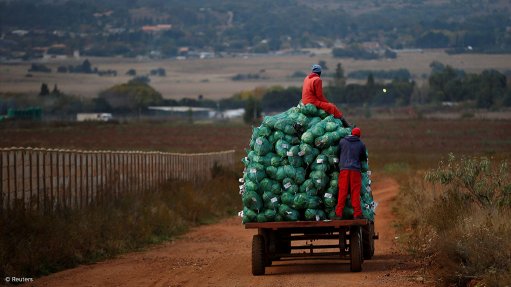
Photo by: Reuters
The Bureau for Food and Agricultural Policy (BFAP) has, in its latest 'Food Inflation Brief', highlighted that South Africa’s food and non-alcoholic beverage (NAB) inflation – hereafter to be referred to simply as food inflation – continued to decelerate in July. However, it also remained far above the rate of consumer price index (CPI) headline inflation. Year-on-year (y-o-y), food inflation in July was 9.9%, which was 1.1 percentage points below June’s y-o-y figure of 11%. However, the CPI headline number in July was 4.7%. In contrast, in month-on-month (m-o-m) terms, food inflation in July was 0.2%, but CPI headline inflation was 0.9%. In July, food inflation contributed 1.7 percentage points to the y-o-y CPI headline inflation figure. In m-o-m terms, however, its contribution was zero percentage points.
Of relevance to various agricultural inputs, in July the rand:dollar exchange rate was R18.19/$1.00, which was an 8% deterioration, y-o-y. And while the CPI index for fuels dropped 16.8%, y-o-y, that for “electricity and other fuels” rose by 14.7%. The continuing scheduled rotating power cuts, called loadshedding, were a challenge, the BFAP pointed out.
The food categories which recorded the highest y-o-y inflation in July were sugar-rich foods (18.7%), vegetables (18.5%), dairy and eggs (14.4%), bread and cereals (13.1%), fish (8.8%), NAB (also 8.8%), meat (5.1%), and fruit (2.6%). Oils and fats recorded y-o-y deflation of 12.9%. In m-o-m terms, the highest food inflation was experienced by sugar-rich foods (2.5%), followed by fruit (1.4%), fish (0.9%), meat (0.4%), and bread and cereals (0.3%). Deflation was reported for NAB (0.3%), vegetables (0.5%), dairy and eggs (also 0.5%) and oils and fats (0.6%).
The food items which experienced y-o-y inflation in July equal to or greater than 30% were (in the order given by the BFAP) onions, potatoes, and frozen potato chips; and Ceylon/black tea. Those with inflation from 20% to just under 30% were instant noodles, cheddar cheese, pineapple, cauliflower, pumpkin, sweet potatoes, white sugar, brown sugar, tomato sauce, salad dressing, and fruit juice concentrates. Food items with inflation from 10% to just under 20% were wheat flour, maize meal; beef fillet, corned beef; pork fillet, bacon, polony; chicken (fresh, frozen but not individually quick frozen) giblets; polony (listed again); fish (frozen hake, fish fingers, canned pilchards); condensed milk, yoghurt, gouda cheese, feta cheese, cream, sour milk, custard, mageu (a traditional indigenous NAB made from fermented maize porridge); apples, papaya; cabbage, broccoli, mushrooms; sugar-rich foods; vinegar, mayonnaise, salt, spices, soup powder; and, coffee, hot chocolate, mineral water and fruit juice.
Food items which saw y-o-y deflation in July were (again in the order given by the BFAP) rice; beef brisket, chuck, T-bone, “stew”; mutton/lamb leg, “stew”; eggs; sunflower oil and canola oil; oranges, avocados; lettuce, sweet peppers, beetroot; and, dried beans.
In July, the BFAP’s Thrifty Healthy Food Basket (THFB) cost R3 552, which was a y-o-y increase of R345, or 9%. However, in m-o-m terms the July number was a decrease of R29, or a decline of 0.8%. The THFB is composed of 26 food items from all the food groups and is nutrionally balanced. It is designed to feed a family of two adults, one older and one younger child, for a month. Assuming that family is earning two minimum wages, is receiving child grants and benefitting from school meals, in July buying the THFB would have consumed 30.9% of the family’s income.
“The volatility and general weakening in the Rand exchange rate over the first half of the year has been a critical driver of food inflation,” pointed out the BFAP. “While expectations are that food inflation rates will continue to moderate over the coming months, the exchange rate will be a key determining factor, as will other costs through the value chain and the intensity of loadshedding.”